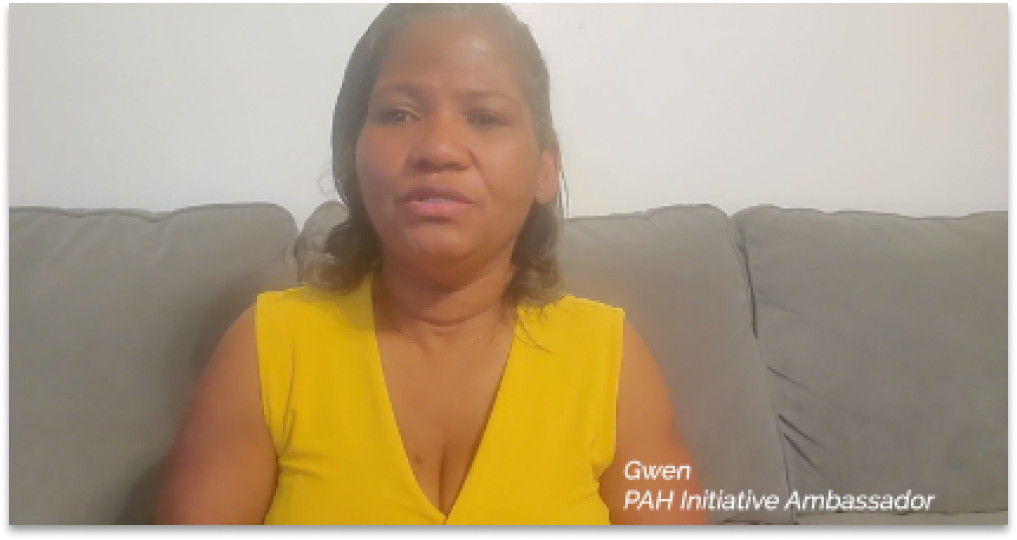[On-screen text: Thekla living with PAH]
When I was diagnosed with PAH, I wanted to learn everything that I could about the disease. PAH is a rare disease, so it can be very hard to find medical professionals who are experts on the disease. I saw several doctors over the years, but I wasn't noticing any improvements in my symptoms.
I started doing my own research about PAH and treatment options. I found the PAH Association's website and got involved in support groups. Learning from others experiences empowered me to be more proactive about my health. I am really happy with the doctor I am seeing currently. The first time we met, he was able to explain to me how PAH affected my entire body from head to toe. Sometimes I bring him information I've researched and other times he brings me new information.
Having a doctor that keeps up with the research on PAH makes me feel like he's on my side. My doctor and I worked together to come up with a treatment plan and to continue to monitor if it's working for me. Tracking and being open about your symptoms is the most important thing you can do to determine your PAH treatment plan. Your healthcare team has to know what you're going through in order to give you proper care.
I talked with my doctor about the different ways to treat PAH. The first treatment that I received was the Prostacyclin-class medication. My PAH was so severe that the doctor wanted to start me on this right away. After a few years on medication, I wasn't noticing any improvement in my symptoms, and I was also experiencing side effects.
[On-screen text: Side effects of intravenous (IV) administration of prostacyclin-class medications can include catheter-related infections]
My doctors and I decided to try another prostacyclin-class treatment. We talked about the available forms. Oral, inhaled, and IV pump. We thought taking it through an IV pump was the right choice for me. We went over all the potential risks and decided to move forward with this treatment.
We also talked through changes I needed to make to my routine to be able to reach specific goals.
[On-screen text: Prostacyclin-class medications may cause side effects. These may be different depending on how you take the medication. Talk to your healthcare provider about possible side effects before you start taking prostacyclin-class therapy. Side effects of prostacyclin-class medications may include: headache, muscle pain, diarrhea, flushing, jaw pain, and nausea]
It is important to discuss treatment options for each pathway with your healthcare team, especially if you're not meeting your healthcare goals. I let my healthcare team know when I experience a new symptom or any new changes. It's important to have an ongoing conversation with your doctor about your treatment plan.
[On-screen text: Prostacyclin-class medications are used to treat 1 of several treatment pathways for PAH. Prostacyclin-class medications have been shown to help people with PAH in several ways, including: Improving PAH symptoms, like shortness of breath and fatigue, do more without symptoms, reduce strain on the heart, keep PAH from getting worse]
Don't be afraid to ask your doctor questions and speak up if you have any concerns. Finding a good health care team to partner with has been such an important part of my journey with PAH. The more we learn about this disease, the more hope I have for the future.
Everyone’s story is unique, especially when you’re living with pulmonary arterial hypertension (PAH).
In this short video, Thekla, a PAH Initiative patient Ambassador, tells her story. She talks about how she’s proactive with her PAH specialist – discussing her PAH symptoms, setting goals, coming up with a treatment plan, and needing to make adjustments to her treatment plan over time. She discusses how learning that PAH can affect the entire body made her think differently about the disease and learning about the 4 PAH treatment pathways –endothelin, nitric oxide, activin signaling, and prostacyclin.

Sign up to receive future magazines, our email newsletter, and other useful resources to help navigate life with PAH.
Sign UpPAH is a complicated disease that can be difficult to understand. We’ve broken it down for you with easy-to-understand information, simple graphics, and informative videos from a PAH specialist.
What Is PAH?
Learn how Peggy renewed her competitive spirit after her PAH diagnosis and how she won't let an oxygen tank define her.
Competitive Spirit with PAH ⟩
How has knowing their risk status helped Lauren and Karen better understand if their treatment plan is working?
Knowing your PAH Risk Status ⟩
Living with PAH can be a big adjustment and taking care of yourself can make a big difference. But where do you start?
Self-Care and Healthy Living ⟩